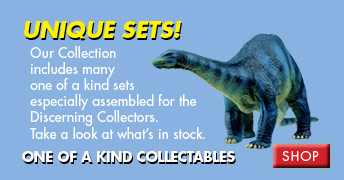
ALL DINOS
Your source for quality museum play sets. Educational sets including Lesson Plans, Activties and Dinosaur figures.




| Schleich Replic Saurus |
|---|
| Schleich Prehistoric Mammals |
| Schleich Standard Dinosaurs |
| Schleich Collectable's |

SCHLEICH Toy Company
Schleich Replica Saurus 1/40 scale 
The Carnegie Museum in Pittsburgh is one of the world’s foremost museums and justly famous for its work in Paleontology. In 1987 Carroll Carmen, the Carnegie Shop Director, came up with the idea to create a line of scientific models - and not just of dinosaurs. She knew Burnie Rubel of Safari, and made a proposal that became one of the most successful partnerships in the toy figure business. Since Safari was primarily an importer, the Bullyland Company in Germany did the tooling for the original run of 17 animals. The first releases were Stegosaurus, Tyrannosaurus, Brachiosaurus, Apatosaurus, Apatosaurus juvenile, Parasaurolophus, Triceratops, Allosaurus, Australopithecus male, Australopithecus female, Diplodocus, Maiasaura on her nest, Euoplocephalus, Dimetrodon, Pteranodon, Protoceratops, and Smilodon.
In 2004, with the introduction of Sinraptor and Albertosaurus, figures 46 and 47 were released. The Carnegie line is a microcosm of the changes in the study of dinosaurs of this period. Of the original 17 dinosaurs, five are retired, six have been replaced with new figures, and four have had a face or tail lift to revise the figures, because of mold fatigue or changes in paleontology. Pteranodon and Diplodocus look to be unchanged in form.
Another indispensable player is Forest Rogers, the sculpture for the Carnegie line. In 1987 she was in Pittsburgh, working toward her MFA at Carnegie-Mellon University. An acquaintance, who was doing some mold making at the Carnegie Museum of Natural History, contacted her about the museum’s dinosaur model plans. Little did she guess what a long lasting project it would be! The Carnegie 3D display elements were designed and originally sculpted by her mother, Lou Rogers. Dr. Mary Dawson, who has retired as Curator of Vertebrate Paleontology at the Carnegie, still honors the dinosaur line with her attention, and new figures are added each year.
First the list of possible new figures is examined; they should be well known and documented. For the 2005 figure, Ankylosaurus, the original Barnum Brown description was used along with the unpublished monograph by Ken Carpenter. An illustration is prepared which goes to Forest Rogers, and if she agrees the proposal goes to Safari. Next, Forest starts her 3D representation. After the model has been created, ideas for the coloring are discussed; one idea for the 2005 Ankylosaurus was to give it eyespots on the tail. 2005's other dinosaur was Oviraptor; coincidentally, the Carnegie just obtained their own Oviraptor fossil, which gave them a first hand reference. One of the ideas was to use parrots as a model for the dinosaur’s plumage. This is the first feathered dinosaur produced for the Carnegie series, but not the first one proposed.
A few years ago, Caudipteryx was proposed, but Safari felt the public wasn't ready for a feathered dinosaur. Based on the sketches, it would have been a spectacular figure. In 2006 the new management at Safari changed their mind, and in addition to the annual 2 - 4 new figures introduced there are also changes being made to existing models along with new paint jobs. Several figures have also been discontinued; Deinonychus, Euoplocephalus, Protoceratops, Smilodon and the Australopithecines. Dimetrodon was replaced by a figure not in a larger scale. The trend is to keep the large figures at 1/40 scale but to use a larger scale to portray smaller animals. Several figures have been modified over time; original Tyrannosaurus received a new head (the original head had the teeth painted on), and a new figure was released. The original Apatosaurus was a tail dragger, so it got a tail lift, and Elasmosaurus originally had a downward striking neck. Allosaurus was also replaced, and Triceratops was repainted and then replaced. Pachycephalosaurus and Triceratops both got black and blue paint jobs, while Parasaurolophus received a new, slimmer head and the Maiasaura sitting on its eggs was replaced with a figure having the solid crest and a separate nest with babies. Stegosaurus was also replaced with a new figure. Most of these changes can be explained by changes in reconstructions based on new data or degradation of the molds over time. Major repaint for 2007.
Safari Home |
Wild Safari |
Email rsknol@aol.com
version 061909
